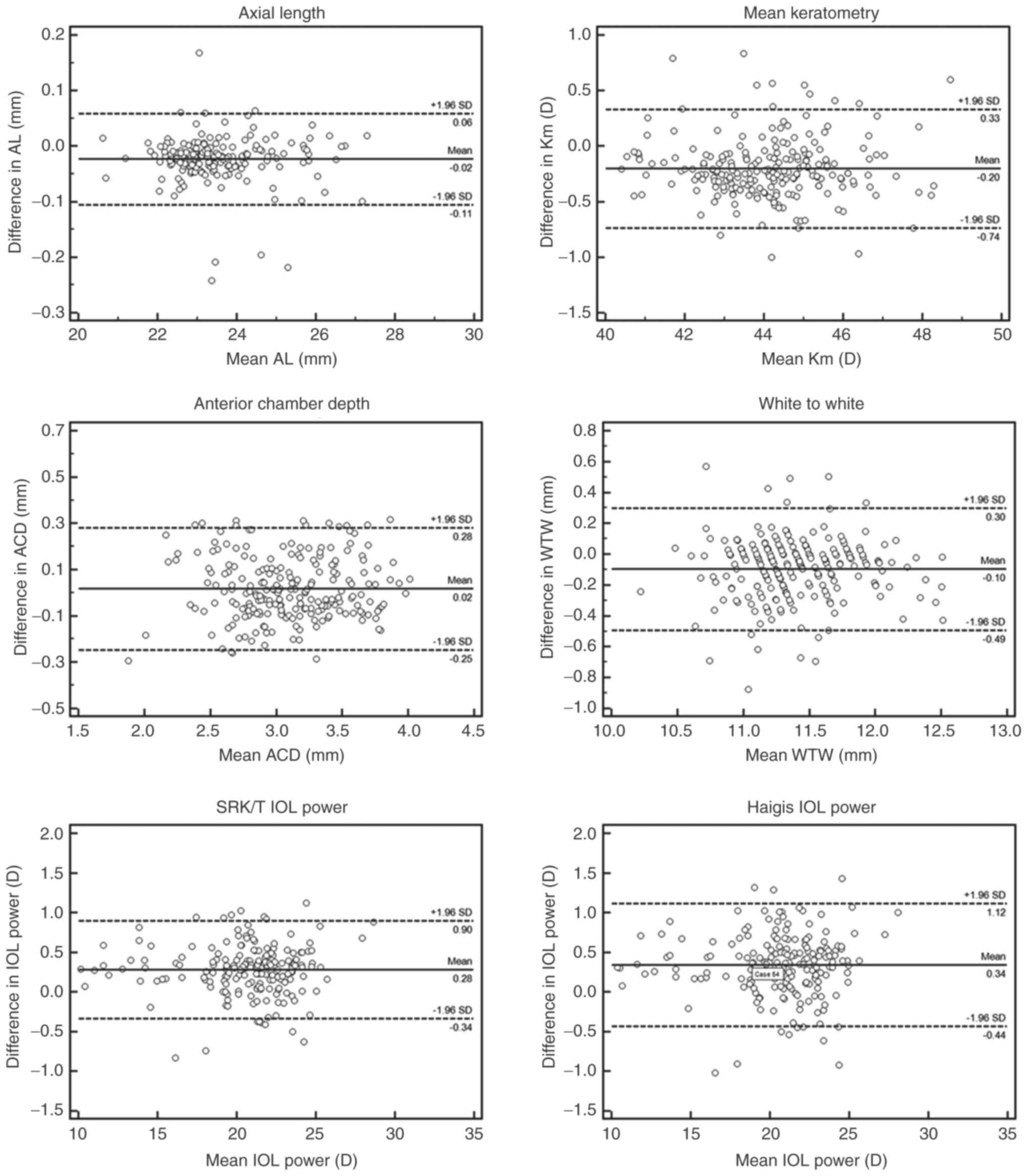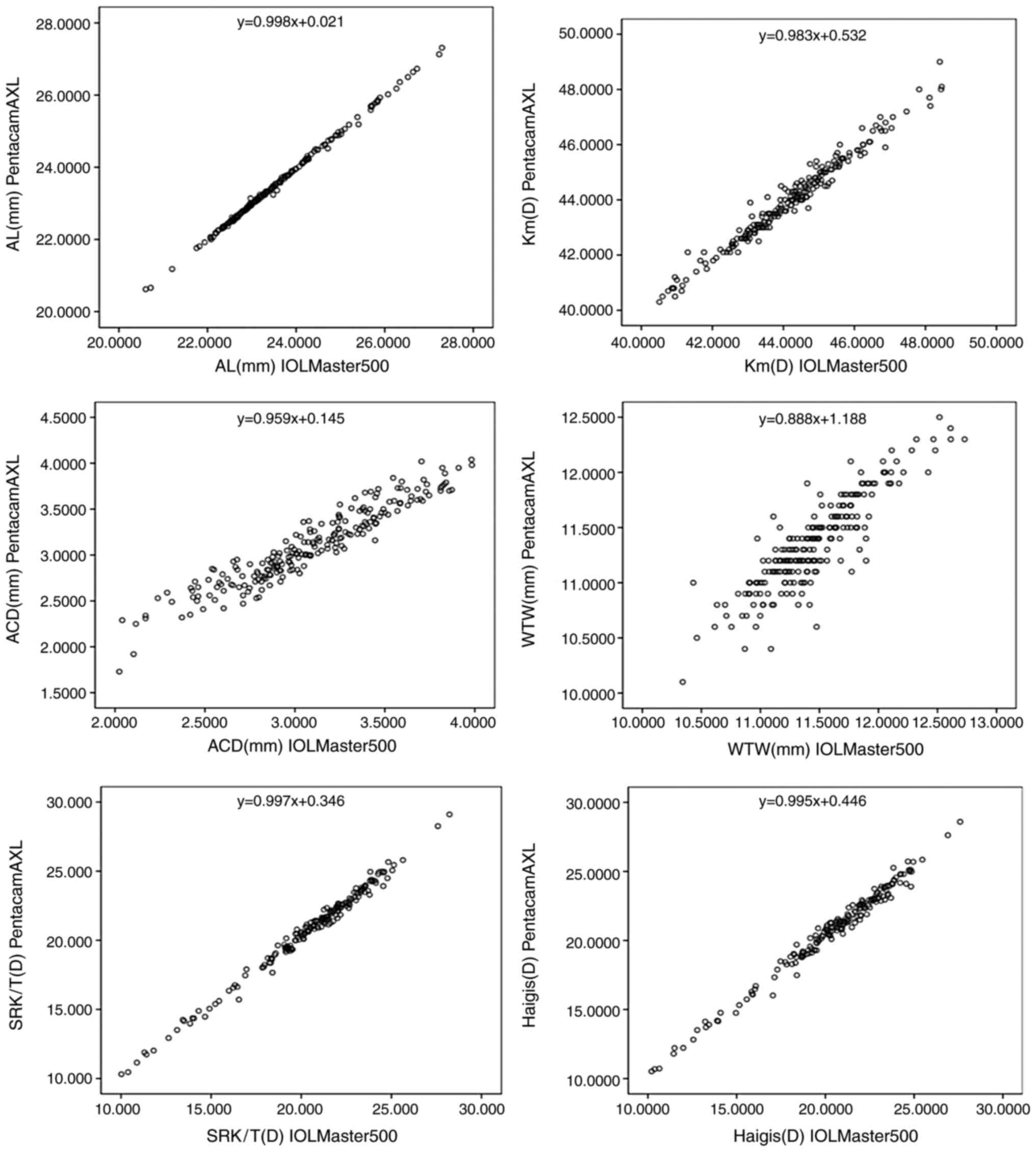|
1
|
Olsen T: Calculation of intraocular lens
power: A review. Acta Ophthalmol Scand. 85:472–485. 2007.PubMed/NCBI View Article : Google Scholar
|
|
2
|
Kitthaweesin K and Mungsing W: Agreement
and reproducibility of contact and immersion techniques for axial
length measurement and intraocular lens power calculation. J Med
Assoc Thai. 92:1046–1049. 2009.PubMed/NCBI
|
|
3
|
Santodomingo-Rubido J, Mallen EA,
Gilmartin B and Wolffsohn JS: A new non-contact optical device for
ocular biometry. Br J Ophthalmol. 86:458–462. 2002.PubMed/NCBI View Article : Google Scholar
|
|
4
|
Ruiz-Mesa R, Abengózar-Vela A and
Ruiz-Santos M: Comparison of a new Scheimpflug imaging combined
with partial coherence interferometry biometer and a low-coherence
reflectometry biometer. J Cataract Refract Surg. 43:1406–1412.
2017.PubMed/NCBI View Article : Google Scholar
|
|
5
|
Sel S, Stange J, Kaiser D and Kiraly L:
Repeatability and agreement of Scheimpflug-based and swept-source
optical biometry measurements. Cont Lens Anterior Eye. 40:318–322.
2017.PubMed/NCBI View Article : Google Scholar
|
|
6
|
Lam AK, Chan R and Pang PC: The
repeatability and accuracy of axial length and anterior chamber
depth measurements from the IOLMaster. Ophthalmic Physiol Opt.
21:477–483. 2001.PubMed/NCBI View Article : Google Scholar
|
|
7
|
Naderan M, Shoar S, Naderan M, Kamaleddin
MA and Rajabi MT: Comparison of corneal measurements in keratoconic
eyes using rotating Scheimpflug camera and scanning-slit
topography. Int J Ophthalmol. 8:275–280. 2015.PubMed/NCBI View Article : Google Scholar
|
|
8
|
User Group for Laser Interference Biometry
(ULIB): Optimized IOL constants for the Zeiss IOLMaster
calculated from patient data on file (as of Oct 31, 2016).
www.ocusoft.de/ulib/c1.html. Last
accessed November 1, 2018.
|
|
9
|
Einan-Lifshitz A, Rozenberg A, Wang L,
Koch DD, Shoshany N, Zadok D, Avni I and Abulafia A: Accuracy and
feasibility of axial length measurements by a new optical
low-coherence reflectometry-based device in eyes with posterior
subcapsular cataract. J Cataract Refract Surg. 43:898–901.
2017.PubMed/NCBI View Article : Google Scholar
|
|
10
|
Ferrer-Blasco T, Domínguez-Vicent A,
Esteve-Taboada JJ, Aloy MA, Adsuara JE and Montés-Micó R:
Evaluation of the repeatability of a swept-source ocular biometer
for measuring ocular biometric parameters. Graefes Arch Clin Exp
Ophthalmol. 255:343–349. 2017.PubMed/NCBI View Article : Google Scholar
|
|
11
|
Kaswin G, Rousseau A, Mgarrech M, Barreau
E and Labetoulle M: Biometry and intraocular lens power calculation
results with a new optical biometry device: Comparison with the
gold standard. J Cataract Refract Surg. 40:593–600. 2014.PubMed/NCBI View Article : Google Scholar
|
|
12
|
Shajari M, Cremonese C, Petermann K, Singh
P, Müller M and Kohnen T: Comparison of axial length, corneal
curvature, and anterior chamber depth measurements of 2 recently
introduced devices to a known biometer. Am J Ophthalmol. 178:58–64.
2017.PubMed/NCBI View Article : Google Scholar
|
|
13
|
Norrby S: Sources of error in intraocular
lens power calculation. J Cataract Refract Surg. 34:368–376.
2008.PubMed/NCBI View Article : Google Scholar
|
|
14
|
McAlinden C, Wang Q, Gao R, Zhao W, Yu A,
Li Y, Guo Y and Huang J: Axial length measurement failure rates
with biometers using swept-source optical coherence tomography
compared to partial-coherence interferometry and optical
low-coherence interferometry. Am J Ophthalmol. 173:64–69.
2017.PubMed/NCBI View Article : Google Scholar
|
|
15
|
McAlinden C, Wang Q, Pesudovs K, Yang X,
Bao F, Yu A, Lin S, Feng Y and Huang J: Axial length measurement
failure rates with the IOLMaster and Lenstar LS 900 in eyes with
cataract. PLoS One. 10(e0128929)2015.PubMed/NCBI View Article : Google Scholar
|
|
16
|
Hill W, Angeles R and Otani T: Evaluation
of a new IOLMaster algorithm to measure axial length. J Cataract
Refract Surg. 34:920–924. 2008.PubMed/NCBI View Article : Google Scholar
|
|
17
|
Symes RJ and Ursell PG: Automated
keratometry in routine cataract surgery: Comparison of Scheimpflug
and conventional values. J Cataract Refract Surg. 37:295–301.
2011.PubMed/NCBI View Article : Google Scholar
|
|
18
|
Savini G, Barboni P, Carbonelli M and
Hoffer KJ: Accuracy of Scheimpflug corneal power measurements for
intraocular lens power calculation. J Cataract Refract Surg.
35:1193–1197. 2009.PubMed/NCBI View Article : Google Scholar
|
|
19
|
Özyol P and Özyol E: Agreement between
swept-source optical biometry and scheimpflug-based topography
measurements of anterior segment parameters. Am J Ophthalmol.
169:73–78. 2016.PubMed/NCBI View Article : Google Scholar
|
|
20
|
Karunaratne N: Comparison of the Pentacam
equivalent keratometry reading and IOL Master keratometry
measurement in intraocular lens power calculations. Clin Exp
Ophthalmol. 41:825–834. 2013.PubMed/NCBI View Article : Google Scholar
|
|
21
|
Lackner B, Schmidinger G and Skorpik C:
Validity and repeatability of anterior chamber depth measurements
with Pentacam and Orbscan. Optom Vis Sci. 82:858–861.
2005.PubMed/NCBI View Article : Google Scholar
|
|
22
|
Muzyka-Woźniak M and Oleszko A: Comparison
of anterior segment parameters and axial length measurements
performed on a Scheimpflug device with biometry function and a
reference optical biometer. Int Ophthalmol. 39:1115–1122.
2019.PubMed/NCBI View Article : Google Scholar
|
|
23
|
Gharaee H, Abrishami M, Shafiee M and
Ehsaei A: White-to-white corneal diameter: Normal values in healthy
Iranian population obtained with the Orbscan II. Int J Ophthalmol.
7:309–312. 2014.PubMed/NCBI View Article : Google Scholar
|
|
24
|
Kohnen T, Kook D, Morral M and Güell JL:
Phakic intraocular lenses: part 2: results and complications. J
Cataract Refract Surg. 36:2168–2194. 2010.PubMed/NCBI View Article : Google Scholar
|
|
25
|
Trivedi RH, Wilson ME and Reardon W:
Accuracy of the Holladay 2 intraocular lens formula for pediatric
eyes in the absence of preoperative refraction. J Cataract Refract
Surg. 37:1239–1243. 2011.PubMed/NCBI View Article : Google Scholar
|
|
26
|
Huang J, Savini G, Wu F, Yu X, Yang J, Yu
A, Yu Y and Wang Q: Repeatability and reproducibility of ocular
biometry using a new noncontact optical low-coherence
interferometer. J Cataract Refract Surg. 41:2233–2241.
2015.PubMed/NCBI View Article : Google Scholar
|
|
27
|
Srivannaboon S, Chirapapaisan C, Chonpimai
P and Loket S: Clinical comparison of a new swept-source optical
coherence tomography-based optical biometer and a time-domain
optical coherence tomography-based optical biometer. J Cataract
Refract Surg. 41:2224–2232. 2015.PubMed/NCBI View Article : Google Scholar
|
|
28
|
Jia L and Li Z: Evaluation of the
consistency of total spherical aberration before and after
aspherical intraocular lens implantation. Eye Sci. 28:129–133.
2013.PubMed/NCBI
|
|
29
|
Zheng T, Chen Z and Lu Y: Influence
factors of estimation errors for total corneal astigmatism using
keratometric astigmatism in patients before cataract surgery. J
Cataract Refract Surg. 42:84–94. 2016.PubMed/NCBI View Article : Google Scholar
|
|
30
|
Jin H, Rabsilber T, Ehmer A, Borkenstein
AF, Limberger IJ, Guo H and Auffarth GU: Comparison of ray-tracing
method and thin-lens formula in intraocular lens power
calculations. J Cataract Refract Surg. 35:650–662. 2009.PubMed/NCBI View Article : Google Scholar
|
















